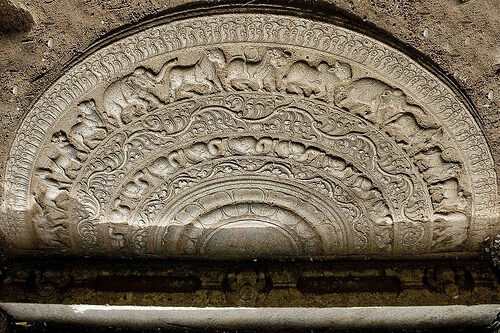King Devanampiyathissa; A Precursor of a New Civilisation..
 Remember, that at the time of the Buddhist Council in 250 BCE, King Mutaseeva in neighbouring Lanka was over 100 years old. In 247 BCE (three years later) the Lankan King passed away and young King Devanampiyathissa was consecrated as the new ruler. Emperor Dharmasoka chose his son Arahat Mahinda to be sent as emissary to Lanka along with Arahaths Ittiya, Uththiya, Sambala, Baddhasala, Suman Samanera (novice) and Bhanduka Upasaka (layman). On the arrival of Arahath Mahinda, Bhanduka Upasaka was ordained, creating awareness and interest in the general population about being ordained and leading an ascetic life. In fact, when Sanghamitta Theri arrived in November of that year, sister-in-law of King Devanampiyatissa (Queen Anula) requested king’s permission to enter novice hood with her retinue, and was ordained. The choice of his own son and daughter as emissaries to be sent to Lanka shows the importance India gave to its relations with Sri Lanka.
Remember, that at the time of the Buddhist Council in 250 BCE, King Mutaseeva in neighbouring Lanka was over 100 years old. In 247 BCE (three years later) the Lankan King passed away and young King Devanampiyathissa was consecrated as the new ruler. Emperor Dharmasoka chose his son Arahat Mahinda to be sent as emissary to Lanka along with Arahaths Ittiya, Uththiya, Sambala, Baddhasala, Suman Samanera (novice) and Bhanduka Upasaka (layman). On the arrival of Arahath Mahinda, Bhanduka Upasaka was ordained, creating awareness and interest in the general population about being ordained and leading an ascetic life. In fact, when Sanghamitta Theri arrived in November of that year, sister-in-law of King Devanampiyatissa (Queen Anula) requested king’s permission to enter novice hood with her retinue, and was ordained. The choice of his own son and daughter as emissaries to be sent to Lanka shows the importance India gave to its relations with Sri Lanka.

Besides the introduction of Buddhism, the Devanampiyatissa reign also marked the golden period of Indo-Lanka relations. The famous first meeting between Arhat Mahinda Thero and King Devanampiyatissa as recorded in the Mahavamsa, may or may not have been a mere accident. Historians such as Professors Mendis Rohanadeera, Indrakirthi Suraweera and Ven.Ellawela Medhananda Thero opine that the introduction of Buddhism was the culmination of excellent diplomatic relations and statesmanship of the highest order of both rulers in Sri Lanka and India.
Dipavamsa and the Mahavamsa confirm that the resolution to send out Dharmadutha Missions to states outside the Maurya Empire was adopted during the third Buddhist Council. It is believed that Emperor Asoka postponed the mission to Sri Lanka until the time was appropriate, as the then king Mutaseeva (367-307 BC), he thought, was too old and feeble for the task. In order to mark time, Arhat Mahinda left for the Dakshinagiri vihara to see his mother and other relatives. He went there with the four Arhats, Itthiya, Utthiya, Sambala and Bhaddasala and the novice Sumana samanera. After six months, the group left for Vidisagiri in Sanchi and lived there until the death of King Mutaseeva. The enthronement of youthful King Devanampiyatissa was much to the liking of the Mayuryan Emperor. Arhat Mahinda, with his companions, left Vidisagiri vihara, bound for Lanka. Unlike the rest of the missionaries, the Lankan missionary group did not return to India immediately. The composition of the group that arrived in Lanka with Sanghamitta Theri in November following Arhat Mahinda’s arrival, supports the view that the goal of the mission was not only to spread the word of the dhamma but also to establish the Buddha Sasana in Lanka.

King Devanampiyatissa on the other hand, when he took over as ruler (307-260 BC) was well aware of the many conquests made by Emperor Dharmashoka and the rapid expansion that was taking place in the Maurya kingdom. Sri Lanka could not match its military strength. His strategy therefore was to establish friendly relations through diplomacy with his formidable neighbour. Displaying ingenious statecraft, he dispatched a high-powered embassy headed by Prime Minister – Mahaaritta, who was his sister’s son with gifts consisting of the most valuable gems and pearls to the Mauryan Emperor. Malla, Minister without portfolio, Talipabbatha, a Brahmin and Tissa, an accountant from the Finance Ministry were included in this delegation. This was the first batch of diplomats in history to leave Sri Lanka on a goodwill mission!
What could be the language spoken for this exchange of information? In the 3rd century BCE, the language in use in Sri Lanka may have been a mixture of the indigenous Hela and a development of the language brought by the Aryans when they came and settled down in Sri Lanka about 200 years earlier. The Aryan settlers came from the Bay of Bengal and some believe that their origin was in the kingdom of Magadha – the area visited by the Sri Lankan embassy. The two parties therefore, may not have found it too difficult to comprehend each other.
The delegates reached Pataliputhra – the capital city of the Maurya kingdom on the first of the month of Il (November) in 248 BCE. It is said that Emperor Dharmasoka was overjoyed by the opportune visit of the Lankan delegation.
According to the Chronicles, the Lankan delegation remained as visitors of the Royalty in the Courts of Emperor Dharmashoka, perhaps at his invitation, until Amavaka in the month of Bak (April) – which works up to 5-6 months. The Dipavamsa however has recorded that the Lankan delegation left Pataliputhra on the day of Vesak, a month later. “They got into a boat on the Ganges river from Palalup and at Thamralipti port boarded a ship and reached Dambakola Patuna on the same day – 12th of the Vesak month and met King Tissa.”
Mahinda Thero may have certainly used the opportunity to acquaint himself with the new language. Chronicles mention that Mahinda Thero delivered his sermons in the Hela language which were recorded by the Buddhist monks in the Tripitaka and other Buddhist Commentaries.
On the same day of the Lankans’ departure, Mahinda Thero, according to documents, had left Palalup city. He had reached Vedisigiri where he had stayed with his mother before leaving his motherland for good.

According to historians, Arhat Mahinda and group reached Lanka one month and three days after the return of the Lankan delegates. In the ancient South Indian Sangam literature, it is stated that in 258 BCE, the Buddhist mission travelling to Sri Lanka, passed through South India. I have doubts on this date as the Lankan delegates of King Devanampiyatissa arrived in Pataliputra in 248 BCE; Arhat Mahinda’s mission started a journey shortly thereafter. Sri Lankan scholars are of the opinion that Mahinda Thero stayed in a monastery constructed by Emperor Asoka on his way to Sri Lanka, propagated the doctrine and set off by sea from Kaveripattinam. Mahawansa, claims that the Arhats arrived on the Mihintale Rock to meet King Devanampiyatissa via miracle (‘irdhi’). Arhat Mahinda met king Devanampiyatissa, when the latter was on a hunting spree towards the wilderness of Mihintale. Chasing wild animals was his famous form of amusement, which he did when he had the opportunity and leisure to do so. Seeing a stag browsing in the thicket, the king’s fine sportive spirit could not brook on the idea of taking the grazing animal unawares. The King disturbed the gracing animal and started to pursue the animal which fled in the direction of Silakuta (the northern peak of Mihintale mountain), the king suddenly came upon Arhat Mahinda and his companions.

After a brief conversation to test the intelligence of the king, preparatory to preaching the Dhamma, the Thero delivered the discourse on Culahastipadopama Sutta (simile on the foot of an elephant), and converted those assembled to Buddhism. This Sutta gives a clear idea of the Buddha, Dhamma and Sangha, and describes how one is converted to Buddhism and becomes a bhikkhu, the sublime qualities he practises and possesses, the things from which he abstains, the various stages of spiritual development in his life and his attainment of arahantship (the final fruit of Buddhism, ceasing rebirth).
Mihintale rock on which the Arhats appeared to deliver Buddhism to King Devanampiyatissai circa 250 BCE
When one considers the difficulties of a group of people trekking across India by foot or carriage, arriving by sea vessel from India and landing on Lanka’s coast and trekking up to the Mihintale Rock miles from the coast, the aerial route through super-human powers as described by Mahawansa, is a welcome alternative. Thus we have very few options but to believe in the version of irdhi-bound travel of the Maurya emissary group to Lanka, as presented in the Mahawansa chronicle.
In fact, Mahavamsa is an excellent source of Sri Lanka’s ancient history written by Venerable Mahanama- a Buddhist monk and remains the backbone of Sri Lanka’s written early history. It should be borne in mind that Venerable Mahanama’s priority in writing the Chronicle was not to record history but to propagate Buddhism. He recorded politics in relevance to Buddhism.
The Venerable monk provided Lanka with continued written reporting of events from the 5th century BCE – a privilege no other nation enjoys and it is now the responsibility of the present and future generations to do the cross-checking as well as protecting it from robbers of culture who prowl incessantly to denigrate, discredit and destroy Mahawansa.
The Mauryan delegation, besides the Arhats, included two of Mahinda Thero’s relatives, his nephew – Sumana samanera who was his sister Theri Sanghamitta’s son and his mother’s sister’s grandson – Bhanduka. Bhanduka became the first to be ordained in Sri Lanka by Mahinda Thero, probably an act carried out as an incentive to draw Lankans to the Bhikkhu Sasana.
The Sri Lankans not only accepted Buddhism but entered the Bhikkhu Sasana in great numbers when Queen Anula, the King’s sister-in-law requested that she too be ordained. Mahinda Thero responding to the request asked the King to send Prime Minister Mahaaritta to the Indian capital once again when Emperor Dharmasoka sent his only daughter Theri Sanghamitta to Sri Lanka to commence the Bhikkhuni Sasana (female nuns order). As it had by this time, proved beyond doubt that Sri Lanka was fertile soil for the establishment of the Buddha Sasana, the Emperor sent with Theri Sanghamitta a sapling from the Southern Branch of the Sacred Sri Maha Bodhi. Accompanying her were eight royal princes, Prime Minister Mahaaritta and 200 from 18 clans of industries, arts and culture in order that they perform customs, traditions and rituals connected with the worship of the Sri Maha Bodhi.

The contribution made by these clans towards building a unique Lankan Buddhist culture, is beyond estimation. However, Mahinda Thero realising that the establishment of the Buddha Sasana alone was not sufficient said that he needed an item of Living Buddha for worship. Sumana Samanera was sent as a result to Pataliputhra and he returned to Sri Lanka with Buddha’s right collar bone – akkha-dhathu in Buddha’s alms bowl along with other relics. The King thereupon, with the guidance of Mahinda Thero, built Sri Lanka’s first Chaitya – Thuparama in Anuradhapura enshrining these relics, thus launching a magnificent tradition of stupa-construction (I believe it is the second, as Thapassu and Bhalluka built Girihandu seya before, during Buddha’s lifetime as mentioned earlier).
Mahinda Thero believed that Buddhism is established in the real sense only once a son of Lankan parents could recite the Buddhist doctrine by heart. Prime Minister Mahaaritta who himself by this time had entered Bhikkhu Sasanaya and had learnt the doctrine had sat by the side of Mahinda Thero at a public Bhikkhu conference at Thuparama when he had recited the entire Buddhist doctrine. It is recorded that it was only after this display that it was accepted that the island could now be called a Buddhist kingdom.
to be continued…
By Ramanie de Zoysa (CA) – Gold Coast








